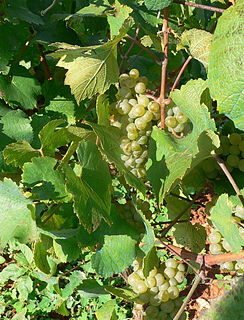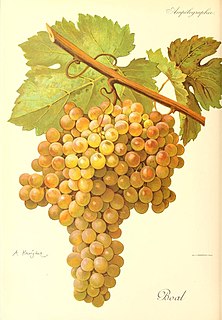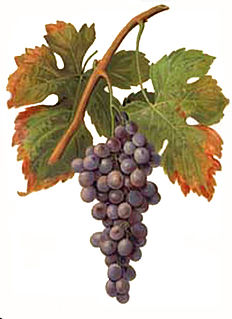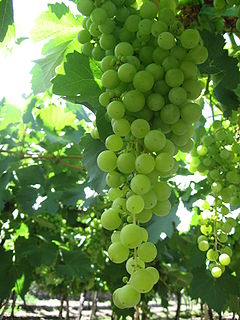Related Research Articles

Rioja [] is a wine region in Spain, with denominación de origen calificada. Rioja wine is made from grapes grown in the autonomous communities of La Rioja and Navarre, and the Basque province of Álava. Rioja is further subdivided into three zones: Rioja Alta, Rioja Oriental and Rioja Alavesa. Many wines have traditionally blended fruit from all three regions, though there is a slow growth in single-zone wines.

Malvasia is a group of wine grape varieties grown historically in the Mediterranean region, Balearic Islands, Canary Islands and the island of Madeira, but now grown in many of the winemaking regions of the world. In the past, the names Malvasia, Malvazia, and Malmsey have been used interchangeably for Malvasia-based wines; however, in modern oenology, "Malmsey" is now used almost exclusively for a sweet variety of Madeira wine made from the Malvasia grape. Grape varieties in this family include Malvasia bianca, Malvasia di Schierano, Malvasia negra, Malvasia nera, Malvasia nera di Brindisi, Malvasia di Candia aromatica, Malvasia odorosissima, and a number of other varieties.

Carignan is a red grape variety of Spanish origin that is more commonly found in French wine but is widely planted throughout the western Mediterranean and around the globe. Along with Aramon, it was considered one of the main grapes responsible for France's wine lake and was a substantial producer in jug wine production in California's Central Valley but in recent years, it has been reborn as a flagship wine for many cellars in the south of France as well as in Catalonia.

Boal is a name given to several varieties of grape cultivated in Portugal, notably in the production of medium-rich fortified wines from Madeira Island. On many wine labels of Madeira wine, the variety's name is anglicized as Bual. Madeira from Bual is typically less sweet than that from Malmsey, but more sweet than Sercial or Verdelho. The vines are also common in Portugal and Spain, where the fruit is used in the same way for fortified wines.

Macabeo, also called Viura or Macabeu, is a white variety of wine grape.

Palomino Fino is a white grape widely grown in Spain and South Africa, and best known for its use in the manufacture of sherry. It is also grown in the Douro region of Portugal where it is used for table and fortified wines.

Airén is a variety of Vitis vinifera, a white grape commonly used in winemaking. This grape is native to Spain where it represents almost a quarter of all grapes grown. As of 2010, Airén was estimated to be the world's 3rd most grown grape variety in terms of planted surface, at 252,000 hectares, down from 306,000 hectares in 2004, where it held 1st place, although it is almost exclusively found in Spain. Since Airén tends to be planted at a low density, several other varieties are more planted in terms of number of vines.

Torrontés is a white grape variety, mostly produced and known in Argentine wine, producing fresh, aromatic wines with moderate acidity, smooth texture and mouthfeel as well as distinctive peach and apricot aromas on the nose. Three Torrontés varieties exist in Argentina: Torrontés Riojano, the most common, Torrontés Sanjuanino, and Torrontés Mendocino. It is primarily Torrontés Riojano that has received attention for the quality of its wines, and is the variety used for most Argentine wines simply labeled Torrontés.

Grenache blanc is a variety of white wine grape that is related to the red grape Grenache. It is mostly found in Rhône wine blends and in northeast Spain. Its wines are characterized by high alcohol and low acidity, with citrus and or herbaceous notes. Its vigor can lead to overproduction and flabbiness. However, if yields are controlled, it can contribute flavor and length to blends, particularly with Roussanne. Since the 1980s, it has been the fifth most widely planted white wine grape in France after Ugni blanc, Chardonnay, Semillon and Sauvignon blanc.

Xarel·lo is a white grape variety of Spanish origin specially grown in Catalonia. With Macabeo and Parellada, it is one of the three traditional varieties used to make the sparkling wine cava. Spanish plantations stood at 8,043 hectares in 2008. Xarel·lo wine can be strongly flavored and is more aromatic than the other two cava grape varieties.

Binissalem is a Spanish Denominación de Origen Protegida (DOP) for wines located around the town of Binissalem in the centre of the island of Majorca,.

Pla i Llevant is a Spanish Denominación de Origen Protegida (DOP) for wines located on the island of Majorca, Balearic Islands, Spain. The name in the Catalan or Majorcan language means "plain and east coast."

Galician wine is Spanish wine made in the autonomous community of Galicia in the northwest corner of Spain. It includes wine made in the provinces of A Coruña, Ourense, Pontevedra and Lugo. Within Galicia are five Denominacións de Orixe (DO): Monterrei, Rías Baixas, Ribeira Sacra, Ribeiro and Valdeorras. In recent years, the region has seen a resurgence in its wine industry led by the international acclaim being received by the Rías Baixas region for its Albariño wines.

Cayetana blanca, also known as Cayetana or Jaén, is a white Spanish wine grape. It is grown mainly in the south of Spain, especially in Extremadura and in the Jerez region where it is distilled for use in brandy production.
Cornifesto is a red Portuguese wine grape variety that is used in the production of Port. In Port production it is considered a minor grape that is usually used to make lighter bodied wines. It originated from the crossing of Castellana Blanca and Alfrocheiro Preto.
Doña Blanca is a white Spanish and Portuguese grape variety that is grown primarily in the northwest Galicia region of Spain and throughout Portugal from the Douro northward. The variety is a permitted grape in the Spanish Denominación de Origens (DOs) of Valdeorras and Monterrei in Galicia and Bierzo in nearby Castile and León. In Spain, the variety is known as Doña Blanca, while in Portugal it goes mainly by the name Doña Branco. The grapes have thick skins, which do well in the wet maritime climate, but it can also impart some astringency and slight bitterness even with the briefest of skin contact during production due to the high proportion of polyphenols in the skin.
Listán Prieto is a red grape variety that is believed to be originated from the Castilla-La Mancha region in Spain. Listán Prieto has disappeared from Spain mainland, but there are still 29 ha planted on the Canary Islands in 2008.

Treixadura or Trajadura is white Portuguese wine grape variety grown primarily in the Vinho Verde wine region of northeast Portugal and the Galician wine regions of Ribeiro and Rías Baixas in Spain where the variety is known as Treixadura. The grape is primarily a blending variety that adds body and light lemony aromatics to wines. It is most commonly blended with Loureiro and Alvarinho in Rías Baixas while in Ribeiro it is often blended with Torrontés and Lado.
Forcallat tinta is a red Spanish wine grape variety that is native to the Castile-La Mancha region of central Spain, as well as in Alicante and Valencia provinces in the Valencian Community. The name of the cultivar means "forked" in Valencian, which probably refers to the bunches having a wing or shoulder, rather than a tendency to produce forked vines as suggested by Favà. It tends to produce pale-colored wines and is most often used as a minor blending component in Vino de la Tierra (VdlT) wines. It is an authorized variety in the Comunitat Valenciana, where it has become almost extinct and only a few wine makers like Rafael Cambra are making efforts to recover it, with interesting proposals like La forcallà d'Antònia. Extant plots are found in Fontanars dels Alforins, La Font de la Figuera, Villena and probably Moixent, though the cultivar was once a prevailing one in La Vall d'Albaida and Alto Vinalopó regions. Bodega la Encina in Villena (Alicante) with vineyards in neighbouring Almansa (Albacete) also works with the variety, offering wines from biodinamic and organic farming. DNA profiling conducted in the early 21st century determined that the white berried Forcallat blanca grape is a distinct variety and not a color mutation of Forcallat tinta. The white cultivar Trepadell is also called Forcallat blanc in the village of La Font de la Figuera, with only one remaining plot of about 600 plants. Trepadell is also present in the Marina Alta region and has been elaborated by Curii uvas & vinos.
Forastera is a white Italian wine grape variety that is grown on the islands of Ischia and Procida off the coast of Naples in Campania. In the early 21st century, DNA analysis confirmed that the Spanish wine grape variety of the same name grown in the Canary Islands is a completely different and distinct variety with no close genetic relationship to the Italian Forastera.
References
- 1 2 J. Robinson, J. Harding and J. Vouillamoz Wine Grapes - A complete guide to 1,368 vine varieties, including their origins and flavours ISBN 978-1-846-14446-2